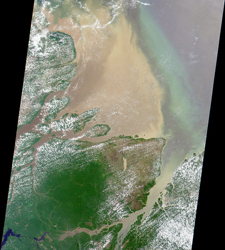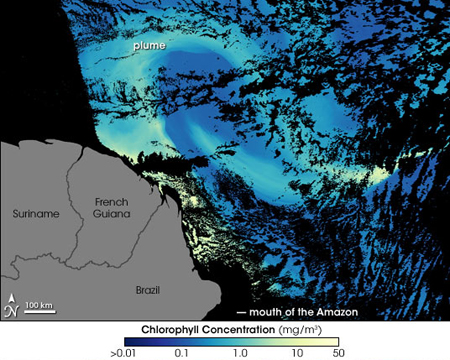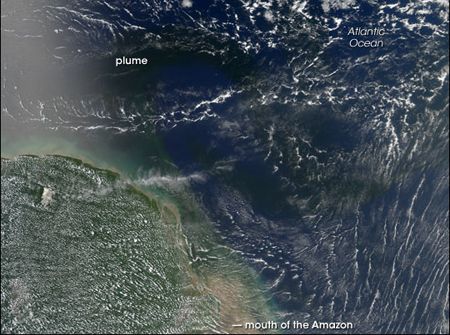5. Stromen in de buurt van rivieren (in het Engels)
Currents Near Rivers
What happens when a river meets a current?

Bron: NASA visable Earth
Rivers flowing out into the ocean can have a massive impact upon the local region. Total global river discharge into the ocean is estimated to be 40,000km3 a year. The Amazon river is the largest river in the world (by outflow volume) and discharges 219,000m3.s of fresh water into the ocean. This equates to 219,000,000 one-litre bottles of water every second, which is rather a lot!
Every year the worlds rivers carry with them an estimated 25 billion tons of sediment and nutrients from the land. This helps to create nutrient rich waters where the rivers flows out into the ocean. In the case of the Amazon this extends out into the Atlantic Ocean.
The outflow from the Amazon is so strong that seawater cannot enter the rivers estuary and a pool of mixed brackish water sits just outside the mouth of the river. This pool is affected by the tide and grows and shrinks with high and low water. It can be seen in the image above and changes in it's extent in the time series on the right.
From this discharge pool the river water is dragged northwards in a plume that can be seen hundreds of kilometres out into the Atlantic. This can be seen in the MODIS images at the bottom of the page. The North Brazilian current is primarily responsible for the direction of flow. After this some of the water is pulled eastwards by the North Equatorial Counter Current, the rest continues north west towards the Carribean.
The outflow is influenced by the trade winds which shift depending up on the time of year and a large shelf extending from Venezuela to Brazil. The estuary has a tidal range of greater than four meters a day and the effects can be seen almost 1000km upstream.
Bron: NASA GSFC
Visable phytoplankton blooms such a great distance from the river mouth are a testament to the large volumes of outflow and the high suspended load. The high chlorophyll concentrations seen below are likely due to the nutrients and decaying vegetation in the plume fertilizing the surrounding water allowing phytoplankton growth. The outflow also has a dilutionary effect upon the surrounding water, lessening the salinity, forming a layer on top of the ocean water that absorbs heat. The combination of these factors, the speed at which the plume moves and it’s large volume mean that it is not rapidly mixed into the Atlantic, thus spreading the effect over a wide area.
2) Can you think why knowing the direction of the plume would be of use?
3) Have a look at the NASA animation above why do you think that the direction of the plume varies so much during the year?


Bron: NASA Earth Observatory
